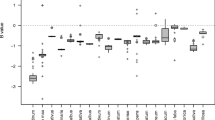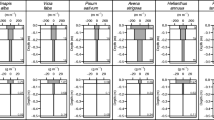Abstract
The agronomic characteristics of different legume cover crops and their effects on soil chemical properties were investigated in a short-term field study. We compared weed biomass, nitrogen equivalence, growth rate, leaf chlorophyll content, cover crop biomass, soil total organic carbon, and soil total nitrogen under eight different legume cover crops in a short-term field experiment. We found the highest growth rate, cover crop dry biomass, N plant content, and N contribution with C. ochroleuca plants, whereas for leaf chlorophyll content, soil organic carbon, and total nitrogen the highest values were found with M. pruriens. We did not find any significant difference among C. ochroleuca and M. pruriens for cover crop dry biomass. Our findings suggest that the incorporation of cover crops into the soil can change positively the soil chemical properties, such as soil organic carbon and total nitrogen. Our results also highlight the importance of considering the short-term effect of cover crops on the tropical soil fertility maintenance, in this case, Regosol.
Similar content being viewed by others
References
Austin, E.E., Wickings, K., McDaniel, M.D., Robertson, G.P., and Grandy, S., Cover crop root contributions to soil carbon in a no-till corn bioenergy cropping system, GCB Bioenergy, 2017, vol. 9, pp. 1252–1263. doi 10.1111/gcbb.12428
Black, C.A., Methods of soil analysis, Part 2, in Agronomy Monograph No. 9, Black, C.A., Ed., Madison, WI: American Society of Agronomy, 1965, pp. 771–1572.
de Costa, W.A.J.M., Dennett, M.D., Ratnaweera, U., and Nyalemgbe, K., Effects of different water regimes on field-grown determinate and indeterminate faba bean (Vicis faba L.). I. Canopy growth and biomass production, Field Crops Res., 1997, vol. 49, nos. 2–3, pp. 83–93. https://doi.org/10.1016/S0378-4290(96)01059-3.
de Souza, T.A.F., Rodrígues, A.F., and Marques, L.F., The trend of soil chemical properties, and rapeseed productivity under different long-term fertilizations and stubble management in a Ferralsols of Northeastern Brazil, Org. Agric., 2017, vol. 7, no. 4, pp. 353–363. doi 10.1007/s13165-016-0164-4
Droppelmann, K.J., Snapp, S.S., and Waddington, S.R., Sustainable intensification options for smallholder maize-based farming systems in sub-Saharan Africa, Food Secur., 2017, vol. 9, no. 1, pp. 133–150.
Fischler, M., Wortmann, C.S., and Feil, B., Crotalaria (C. ochroleuca G. Don.) as a green manure in maizebean cropping systems in Uganda, Field Crops Res., 1999, vol. 61, pp. 97–107.
Gao, W., Yang, J., Ren, S., and Hailong, L., The trend of soil organic carbon, total nitrogen, and wheat and maize productivity under different long-term fertilizations in the upland fluvo-aquic soil of North China, Nutr. Cycl. Agroecosyst., 2015, vol. 103, no. 1, pp. 61–73. doi 10.1007/s10705-015-9720-7
IUSS Working Group WRB, World reference base for soil, World Soil Resour. Rep., 2006, no.103.
Johnson, J.M.F., Novak, J.M., Varvel, G.E., et al., Crop residue mass needed to maintain soil organic carbon levels: Can it be determined?, Bioenergy Res., 2014, vol. 7, pp. 481–490.
Jones, D.L., Nguyen, C., and Finlay, R.D., Carbon flow in the rhizosphere: Carbon trading at the soil-root interface, Plant Soil, 2009, vol. 321, pp. 5–33.
Kallenbach, C.M., Grandy, A.S., Frey, S.D., and Diefendorf, A.F., Microbial physiology and necromass regulate agricultural soil carbon accumulation, Soil Biol. Biochem., 2015, vol. 91, pp. 279–290.
Kong, A.Y.Y. and Six, J., Tracing root vs. residue carbon into soils from conventional and alternative cropping systems, Soil Sci. Soc. Am. J., 2010, vol. 74, pp. 1201–1210.
Lindoso, D.P., Rocha, J.D., Debortoli, N., Parente, I.I., Eiró, F., Bursztyn, M., and Rodrigues-Filho, S., Integrated assessment of smallholder farming’s vulnerability to drought in the Brazilian semi-arid: A case study in Ceará, Clim. Change, 2014, vol. 127, no. 1, pp. 93–105. doi 10.1007/s10584-014-1116-1
McDaniel, M.D., Tiemann, L.K., and Grandy, A.S., Does agricultural crop diversity enhance soil microbial biomass and organic matter dynamics?, A meta-analysis, Ecol. Appl., 2014, vol. 24, pp. 560–570.
Mendez-Millan, M., Dignac, M.-F., Rumpel, C., Rasse, D.P., and Derenne, S., Molecular dynamics of shoot vs. root biomarkers in an agricultural soil estimated by natural abundance 13C labeling, Soil Biol. Biochem., 2010, vol. 42, pp. 169–177.
Okalebo, J.R., Gathua, K.W., and Woomer, P.L., Laboratory Methods of Plant and Soil Analysis: A Working Manual. Technical Bulletin No. 1 Soil Science Society East Africa, 2014.
Olsen, S.R., Cole, C.V., Watanable, F.S., and Dean, L.A., Estimation of Available Phosphorous in Soils by Extraction with Sodium Bicarbonate, Washigton, DC: US Department of Agriculture, 1954.
Palm, C.A., Gachengo, C.N., Delve, P.J., Cadisch, G., and Giller, K.E., Organic inputs for soil fertility man agement in tropical agroecosystems: Application of an organic resource database, Agric. Ecosyst. Environ., 2001, vol. 83, pp. 27–42.
Perin, A., Santos, R.H.S., Urquiaga, S., Guerra, J.G.M., and Cecon, P.R., Produção de fitomassa, acúmulo de nutrientes e fixação biológica de nitrogênio por adubos verdes em cultivo isolado e consorciado, Pesqui. Agropecu. Bras., 2004, vol. 39, no. 1, pp. 35–40.
Poeplau, C., Reiter, L., Berti, A., and Kätterer, T., Qualitative and quantitative response of soil organic carbon to 40 years of crop residue incorporation under contrasting nitrogen fertilization regimes, Soil Res., 2017, vol. 55, no. 1, pp. 1–9.
Rodrigues, A.F., de Souza, T.A.F., Marques, L.F., Souto, J.S., and da Silva, W.P., Agricultural management practices: Effects on soil properties, root growth and sesame yield, Russ. Agric. Sci., 2016, vol. 42, no. 5, pp. 321–327. doi 10.3103/S1068367416050165
Sainju, U.M., Singh, H.P., and Singh, B.P., Cover crops for enriching soil carbon and nitrogen under bioenergy Sorghum, in Global Soil Security, Field D.J., Morgan C.L.S., McBratney A.B., Eds., Springer, 2017, pp. 181–192.
Teodoro, R.B., et al., Aspectos agronômicos de leguminosas para adubação verde no cerrado do Alto Vale do Jequitinhonha, Rev. Bras. Cienc. Solo, 2011, vol. 35, pp. 635–643.
Tian, G., Kang, B.T., and Brussaard, L., Effects of chemical composition on N, Ca, and Mg release during incubation of leaves from selected agroforestry and fallow plant species, Biogeochemistry, 1992, vol. 16, no. 2, pp. 103–119.
Tiemann, L.K., Grandy, A.S., Atkinson, E.E., Marin-Spiotta, E., and McDaniel, M.D., Crop rotational diversity enhances belowground communities and functions in an agroecosystem, Ecol. Lett., 2015, vol. 18, pp. 761–771.
Uzun, B. and Çagirgan, M.I., Comparison of determinate and indeterminate lines of sesame for agronomic traits, Field Crops. Res., 2006, vol. 96, no. 1, pp. 13–18. http://dx.doi.Org/10.1016/j.fcr.2005.04.017
Wang, F., Weil, R.R., and Nan, X., Total and permanganate-oxidizable organic carbon in the corn rooting zone of US Coastal Plain soils as affected by forage radish cover crops and N fertilizer, Soil Tillage Res., 2017, vol. 165, pp. 247–257.
Witham, F.H., Blaydes, D.F., and Devlin, R.M., Experiments in Plant Physiology, New York: D. Van Nostrand, 1971, pp. 55–58.
Wittwer, R.A., Dorn, B., Jossi, W., and van der Heijden, M.G.A., Cover crops support ecological intensification of arable cropping systems, Sci. Rep., 2017, vol. 7. doi 10.1038/srep41911
Yamoah, C.F. and Mayfield, M., Herbaceous legumes as nutrient sources and cover crops in the Rwandan highlands, Biol. Agric. Hortic., 1990, vol. 7, pp. 1–15.
Zar, J.H., Biostatistical Analysis, Prentice Hall, 1984.
Author information
Authors and Affiliations
Corresponding author
Additional information
The article is published in the original.
About this article
Cite this article
da Silva Souza, G.A.V., de Souza, T.A.F., Santos, D. et al. Agronomic Evaluation of Legume Cover Crops for Sustainable Agriculture. Russ. Agricult. Sci. 44, 31–38 (2018). https://doi.org/10.3103/S1068367418010093
Received:
Published:
Issue Date:
DOI: https://doi.org/10.3103/S1068367418010093




